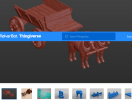ge_rik
British narrow gauge (esp. Southwold and W&LLR)
I've just posted a beginners' guide to 3d printing on my blog.
https://riksrailway.blogspot.com/2021/1 ... nting.html
I've tried to keep it straightforward and uncomplicated so as not to deter someone who's thinking about taking the plunge while also trying to give them a feel for what's involved.
I'd be interested in any feedback as to what you think is ok, where there is information overload or what essential information is missing.
Rik
PS Or spot any errors or typos as has already been spotted
https://riksrailway.blogspot.com/2021/1 ... nting.html
I've tried to keep it straightforward and uncomplicated so as not to deter someone who's thinking about taking the plunge while also trying to give them a feel for what's involved.
I'd be interested in any feedback as to what you think is ok, where there is information overload or what essential information is missing.
Rik
PS Or spot any errors or typos as has already been spotted
Last edited:

